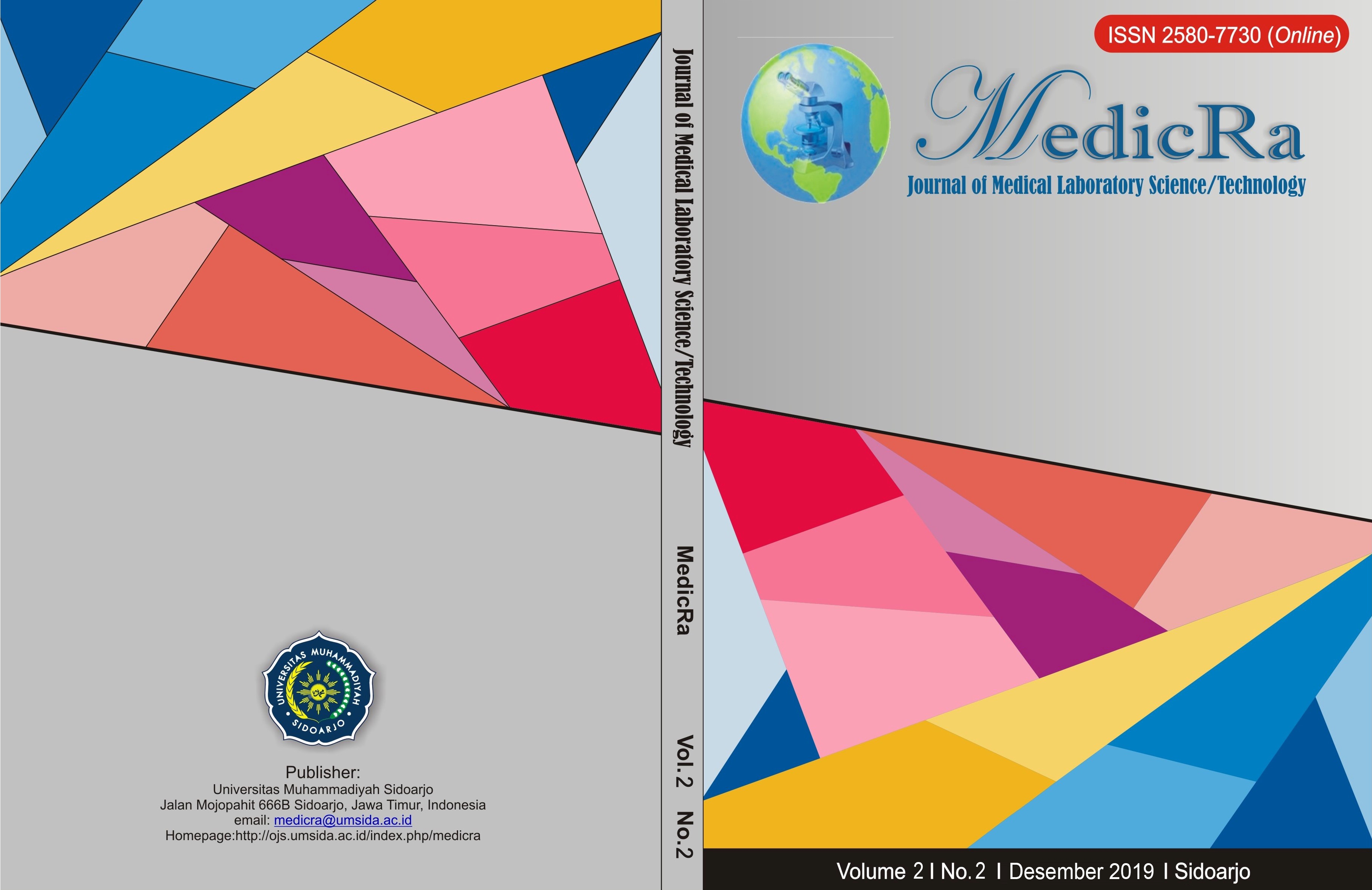Formulasi dan Evaluasi Sabun Cair Ekstrak Etanol Okra (Abelmochus esculentus) serta Uji Antibakterinya
Formulation and Evaluation of Okra (Abelmochus esculentus) Ethanol Extract Liquid Soap and Its Antibacterial Test
DOI:
https://doi.org/10.21070/medicra.v2i2.1657Keywords:
minyak biji bunga matahari, okra (Abelmoshus esculentus), Sabun cair antibakteri, Staphylococcus epidermidisAbstract
Liquid soap is a liquid form that serves to cleanse the skin. The aim of this research are to know the optimization formulation and evaluation of liquid soap extract ethanol okra ( ) and also find the best concentration of okra extract as the inhibitors against Staphylococcus . Experimental laboratory was chosen as the research design. Liquid soap consists of 5 formulations, namely formulation 1, 2, 3, 4, and 5 which consist of 0%, 25%, 50%, 75% and 100% okra concentration. The antibacterial effectiveness was tested by disc method against liquid soap extract ethanol okra ( ) and the clear zone measured. The analysis done with two-way test. The results of the evaluation of liquid soap quality was appropriate with the standard of soap quality established by SNI 1994. The best moisture value found in the formulation of 5 (F5) with 0%form of 3.54%, the best free fatty acid found in formulation 4 (F4) with a concentration of 50% of 0.07135%, the best free alkali concentration was found in formulation 2 (F2) with a 25% concentration of 0.04194%, the best pH value was presented at concentrations of 0%, 25%, and 50% with a value of 9, the best value of foam stability found in Formula 1 (F1) with a 100% concentration of 9.1, the best density (BJ) test found in Formula 4 (F4) with 0% concentration. The result of ANOVA test with variation of ethanol okra concentration obtained p-value = 0.000 <0.05 which states there was a significant difference where liquid soap extract ethanol okra has antibacterial to Staphylococcus . The best inhibitory zone test resulted in formation 5 (F5) of 14.7 mm at 100% concentration.
References
Azrifitria, Aziz, S., & Chairul. (2010). Aktivitas antibakteri ekstrak etanolik daun dan umbi Crinum asiaticum L. terhadap bakteri penyebab jerawat. Majalah Farmasi Indonesia, 21(4), 236-241.
Cushnie, T., & Lamb, A. J. (2012). Antimicrobial Activity of Flavonoids. Int J Antimicrob Agents, 26(5), 343-356. Retrieved from https://www.ncbi.nlm.nih.gov/pubmed/16323269
Hernani, Bunasor, T. K., & Fitriati. (2010). Formula Sabun Transparan Antijamur dengan Bahan Aktif Ekstrak Lengkuas. Buletin Penelitian Tanaman Rempah dan Obat, 21(2), 192-205. Retrieved from http://ejurnal.litbang.pertanian.go.id/index.php/bultro/article/view/1876/5598
Jawetz, E., Melnick, J. L., & Adelberg, E. A. ( 2001). Mikrobiologi untuk Profesi Kesehatan (Review of Medical Microbiology), Edisi ke-16. Jakarta: EGC.
Neldawati, Ratnawulan, & Gusnadi. (2013). Analisis Nilai Absorbansi dalam Penentuan Kadar Flavonoid untuk Bebagai Jenis Daun Tanaman Obat. PILLAR OF PHYSICS, vol. 2, 76-83. Retrieved from http://ejournal.unp.ac.id/students/index.php/fis/article/viewFile/756/513
Onemli, F. (2012). Changes in Oil Fatty Acid Composition During Seed Development of Sunflower. Asian Journal of Plant Sciences, 11 (5), 241-245. doi: 10.3923/ajps.2012.241.245
Qisti, R. (2009). Sifat Kimia Sabun Cair dengan Penambahan Madu pada Konsentrasi yang Berbeda. Skripsi. Fakultas Peternakan. Institut Pertanian Bogor. Bogor.
Seidel, V. (2008). Initial and Bulk Extraction. In: Sarker, S. D., Latif, Z. and Gray, A. I., editors. Natural Products Isolation. 2nd Ed. New Jersey: Humana Press.
Standar Nasional Indonesia (1994). SNI 06-3532-1994: Sabun Mandi. Badan Standarisasi Nasional. Jakarta. Retrieved from http://standar-nasional-indonesia/badan-standar-nasioanl//cara-membuat-sabun-batang-transparan.html.
Sinko, P. J. (2011). Martin Farmasi Fisika dan Ilmu Farmasetika edisi 5. Diterjemahkan oleh Tim Alih Bahasa Sekolah Farmasi ITB. Jakarta: Buku Kedokteran ECG.
Spitz, L. (1996). Soap and Detergents-A Theorical and Practical Review. Champaign: AOCS Press.
Sunarjono, H. (2014). Bertanam 36 Jenis Sayur. Jakarta: Penerbit Penebar Swadaya.
Toy, T. S. S., Lampus, B. S., & Hutagalung, B. S. P. (2015). Uji Daya Hambat Ekstrak Rumput Laut Gracilaria sp Terhadap Pertumbuhan Bakteri Staphylococcus aureus. Jurnal e-GiGi (eG), 3(1), 153-159. Retrieved from https://ejournal.unsrat.ac.id/index.php/egigi/article/view/6600.
Tranggono, R.I. (2007). Buku Pegangan Ilmu Pengetahuan Kosmetik. Jakarta: Penerbit PT Gramedia Pustaka Utama.
Widyasanti, A., Rohdiana, D., & Ekatama, N. (2016). Aktivitas Antioksidan Ekstrak Teh Putih (Camelllia sinensis) dengan Metode DPPH (2,2-Difenil-1- Pikrihidrazil). Jurnal FORTECH, 5(3), 125-136. Retrieved from https://www.researchgate.net/publication/309825410.
Williams D. F., & Schmitt W. H. (2002). Kimia dan Teknologi Industri Kosmetika dan Produk-Produk Perawatan Diri. Terjemahan. FATETA. Bogor: IPB. Retrieved from https://Journal.ipb.ac.id/index.php/jurnaltin/article/view/4304/2917






